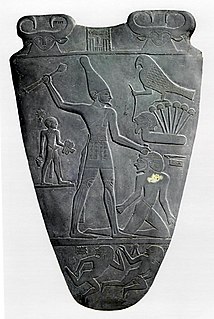
Narmer was an ancient Egyptian pharaoh of the Early Dynastic Period. He was the successor to the Protodynastic king Ka. Many scholars consider him the unifier of Egypt and founder of the First Dynasty, and in turn the first king of a unified Egypt. A majority of Egyptologists believe that Narmer was the same person as Menes.

Hor-Aha is considered the second pharaoh of the First Dynasty of Egypt by some Egyptologists, while others consider him the first one and corresponding to Menes. He lived around the 31st century BC and is thought to have had a long reign.

Djet, also known as Wadj, Zet, and Uadji, was the fourth pharaoh of the First Dynasty. Djet's Horus name means "Horus Cobra" or "Serpent of Horus".

Huni was an ancient Egyptian king and the last pharaoh of the Third Dynasty of Egypt during the Old Kingdom period. Following the Turin king list, he is commonly credited with a reign of 24 years, ending c. 2613 BC.

Scorpion II, also known as King Scorpion, was a ruler during the Protodynastic Period of Upper Egypt.

Umm El Qaʻāb is a necropolis of the Early Dynastic Period kings at Abydos, Egypt. Its modern name means "Mother of Pots" as the whole area is littered with the broken pot shards of offerings made in earlier times. The cultic ancient name of the area was (w-)pkr or (rꜣ-)pkr "District of the pkr[-tree]" or "Opening of the pkr[-tree]", belonging to tꜣ-dsr "the secluded/cleared land" (necropolis) or crk-hh "Binding of Eternity".

Iry-Hor was a predynastic pharaoh of Upper Egypt during the 32nd century BC. Excavations at Abydos in the 1980s and 1990s and the discovery in 2012 of an inscription of Iry-Hor in the Sinai confirmed his existence. Iry-Hor is the earliest ruler of Egypt known by name and is sometimes cited as the earliest-living historical person known by name.

Nebra or Raneb is the Horus name of the second early Egyptian king of the 2nd Dynasty. The exact length of his reign is unknown since the Turin canon is damaged and the year accounts are lost. Manetho suggests that Nebra's reign lasted 39 years, but Egyptologists question Manetho's view as a misinterpretation or exaggeration of information that was available to him. They credit Nebra with either a 10- or 14-year rule.
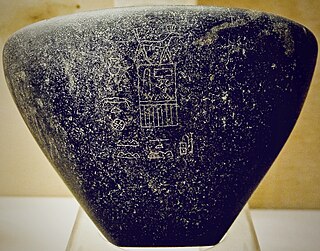
Seth-Peribsen is the serekh name of an early Egyptian monarch (pharaoh), who ruled during the Second Dynasty of Egypt. His chronological position within this dynasty is unknown and it is disputed who ruled both before and after him. The duration of his reign is also unknown.

Anedjib, more correctly Adjib and also known as Hor-Anedjib, Hor-Adjib and Enezib, is the Horus name of an early Egyptian king who ruled during the 1st Dynasty. The Egyptian historian Manetho named him "Miebîdós" and credited him with a reign of 26 years, whilst the Royal Canon of Turin credited him with an implausible reign of 74 years. Egyptologists and historians now consider both records to be exaggerations and generally credit Adjib with a reign of 8–10 years.
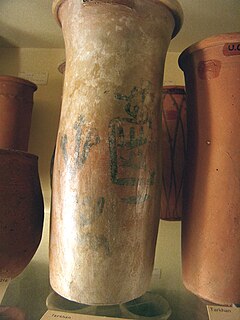
Ka, also (alternatively) Sekhen, was a Predynastic pharaoh of Upper Egypt belonging to Dynasty 0. He probably reigned during the first half of the 32nd century BC. The length of his reign is unknown.

Günter Dreyer was an Egyptologist at the German Archaeological Institute. In southern Egypt, Dreyer discovered records of linen and oil deliveries which have been carbon-dated to between 3300 BCE and 3200 BCE, predating the Dynastic Period.

Neithhotep or Neith-hotep was an ancient Egyptian queen consort living and ruling during the early First Dynasty. She was once thought to be a male ruler: her outstandingly large mastaba and the royal serekh surrounding her name on several seal impressions previously led Egyptologists and historians to the erroneous belief that she might have been an unknown king. As the understanding of early Egyptian writings developed, scholars learned that Neithhotep was in fact a woman of extraordinary rank. She was subsequently considered to be the wife of unified Egypt's first pharaoh, Narmer, and the mother of Hor-Aha.

In 1985, the German Archaeological Institute discovered seal impressions of a cylinder seal in the tomb of First Dynasty king Den. They were published by Günter Dreyer the following year. The impressions are the earliest confirmed king list for ancient Egypt.

Double Falcon was a ruler of Lower Egypt from Naqada III. He may have reigned during the 32nd century BC. The length of his reign is unknown.
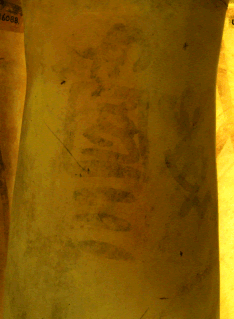
Crocodile is the provisional name of a predynastic ruler, who might have ruled during the late Naqada III epoch. The few alleged ink inscriptions showing his name are drawn very sloppily, and the reading and thus whole existence of king "Crocodile" are highly disputed. His tomb is unknown.
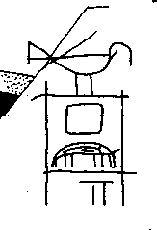
Elephant is the provisional name of a Predynastic ruler in Egypt. Since the incarved rock inscriptions and ivory tags showing his name are either drawn sloppily, or lacking any royal crest, the reading and thus whole existence of king "Elephant" are highly disputed.
The pyramid of Elephantine is part of a group of seven very similar small step pyramids, along with the pyramids at Edfu South, el-Kula, Naqada, Saujet el-Meitin, Seila, and Sinki. All of these were built far from the main centres of Egypt and are very poorly understood. The pyramid of Elephantine is located in the northwest part of the Old Kingdom city on the south end of the island of Elephantine in the Nile. The structure was discovered in 1907, but it could only be identified as a pyramid after excavations by the German Archaeological Institute in 1978–79.
Hedju Hor was a ruler in northern Egypt from the Predynastic Period. His existence is controversial. The name Hedju-Hor means The maces of Horus.
Bull or Taurus is the makeshift name for a predynastic ruler, the existence of whom is highly controversial. He is considered a ruler of the late pottery neolithic Naqada III culture of southern Egypt.




















